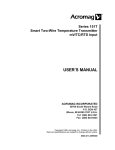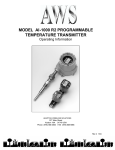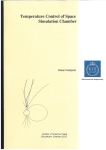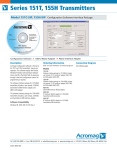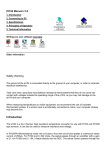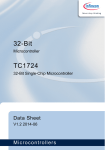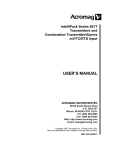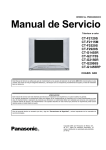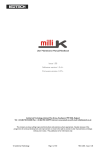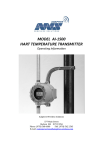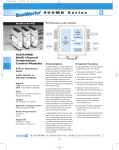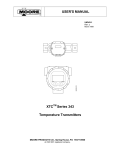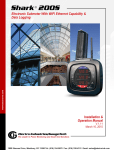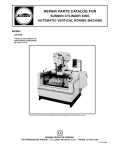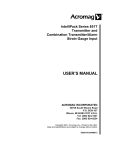Download USER`S MANUAL
Transcript
Series 155H Smart Two-Wire Temperature Transmitter w/ HART Protocol Support mV/TC/RTD Input USER’S MANUAL ACROMAG INCORPORATED 30765 South Wixom Road P.O. BOX 437 Wixom, MI 48393-7037 U.S.A. Tel: (248) 624-1541 Fax: (248) 624-9234 Copyright 1999, Acromag, Inc., Printed in the USA. Data and specifications are subject to change without notice. 8500-610-A99H000 Series 155H HART Two-Wire Transmitter User’s Manual mV/TC/RTD Input ___________________________________________________________________________________________ The information contained in this manual is subject to change without notice. Acromag, Inc., makes no warranty of any kind with regard to this material, including, but not limited to, the implied warranties of merchantability and fitness for a particular purpose. Further, Acromag, Inc., assumes no responsibility for any errors that may appear in this manual and makes no commitment to update, or keep current, the information contained in this manual. No part of this manual may be copied or reproduced in any form, without the prior written consent of Acromag, Inc. Table of Contents Page 1.0 INTRODUCTION ………………………………..….…. DESCRIPTION ………………………………………… Key 155H Features………………………................ ACCESSORY ITEMS …………………………………. DIN Rail Mounting Kit............................................. LCD Display & Field Configurator................……… Explosion Proof Housing............…………………… Pipe Mounting Kit................................................... Software Interface Package…..……….................. 2.0 PREPARATION FOR USE ….……………………….. UNPACKING AND INSPECTION …………………… INSTALLATION ……………………………………….. Mounting ……………………………………………… Electrical Connections ……………………………… 3.0 MODULE CONFIGURATION ……………………….. FIELD CALIBRATION/CONFIGURATION….………. General Display Mode Program Procedure………. 4.0 THEORY OF OPERATION ………………………….. 5.0 SERVICE AND REPAIR ……………………………… SERVICE AND REPAIR ASSISTANCE ……………. PRELIMINARY SERVICE PROCEDURE ..…………. 6.0 SPECIFICATIONS ……………………………………. MODEL NUMBER DEFINITION……………………… INPUT SPECIFICATIONS ……………………………. OUTPUT SPECIFICATIONS…….................……..… ENCLOSURE/PHYSICAL SPECIFICATIONS …….. APPROVALS ………………………………………….. ENVIRONMENTAL SPECIFICATIONS….………….. CONFIGURATION……………………………...……... ACCESSORIES………………………………………… List of Drawings 2 2 3 3 3 3 4 4 4 4 4 4 5 5 5 6 6 10 10 10 10 10 10 11 12 13 13 13 13 13 These instructions cover the hardware functionality of the HART transmitter model listed in Table 1. See Specifications for specific model details. Refer to Accessories to add functionality to this model. Supplementary sheets are attached for units with special options or features not covered in this manual. Table 1: Model Covered in This Manual Series/ -Approvals1/Output/ -Factory Input/Type Mounting/Power Configuration2 155H -0600 -C Notes (Table 1): 1. Agency approvals include CE, CSA, and FM. 2. Each module is shipped with a default factory configuration that can be easily reconfigured to suit your needs. To receive modules with a specific configuration to match your application, consult the factory or your local representative. Information regarding the HockeyPuck Configuration Software and PC/155H HART Interface Adapter can be found in Transmitter Configuration Manual 8500-612. Information on configuration of this transmitter using the after-market, Model 275 Hand-Held HART Configurator can be found in the Model 275 Transmitter Configuration Manual (8500-613). Additional information and literature regarding the HART communication protocol can be found by accessing the HART Communication Foundation web site at http://www.hartcomm.org. Note that Acromag also offers this transmitter without HART support. Refer to Acromag Model 151T Transmitters for more information. DESCRIPTION Series 155H Two-Wire Transmitters are members of the popular Acromag transmitter, isolator, and alarm family. These compact “puck style” transmitters will condition a DC voltage, thermocouple, or RTD input, and provide an isolated 4-20mA process current output signal for two-wire process loops. The 155H models are programmable via the industry standard HART protocol and our user-friendly Windows 95/98 or NT HockeyPuck Configuration Software, or via the push-buttons of the optional ATWTLD display. Page 155H Simplified Schematic (4501-762)….…………….…. 155H Computer to Module Connections (4501-763)……. 155H Electrical Connections (4501-764, Figure A)…..…. 155H Electrical Connections (4501-764, Figure B)…..…. ATW-TLD Display Dimensions (4501-765).……..………. 155H Enclosure Dimensions (4501-766) …………….….. ATW-XPW Housing Dimensions (4501-767)……………. ATW-DIN DIN Rail Mounting Details (4501-770).........…. ATW-PM2 Pipe Mounting Details (4501-768)…….......…. 1.0 INTRODUCTION 15 16 17 18 19 20 21 22 23 Each module provides a single input for either DC millivolts, thermocouple, or RTD signals. RTD sensor excitation, linearization, lead-wire compensation, and lead break detection are included. Thermocouple reference-junction compensation, linearization, and open circuit or TC break detection is also provided. This transmitter also includes a built-in 22-point linearizer function. IMPORTANT SAFETY CONSIDERATIONS It is very important for the user to consider the possible adverse effects of power, wiring, component, sensor, or software failures in designing any type of control or monitoring system. This is especially important where economic property loss or human life is involved. It is important that the user employ satisfactory overall system design. It is agreed between the Buyer and Acromag, that this is the Buyer's responsibility. Following basic two-wire design, the output and DC power share the same pair of twisted copper wires. The transmitter connected in series with a load and DC supply provides an output loop current proportional to the input signal. Communication with this model is also done over the output wires using the HART communication protocol. Field programmability of the unit in the absence of a host computer and HART Interface Adapter may also be accomplished via the optional LCD display (ATW-TLD), or an after-market, Model 275 Hand-Held HART Configurator. Windows 95/98/NT are registered trademarks of Microsoft Corp. -2- Series 155H HART Two-Wire Transmitter User's Manual mV/TC/RTD Input ___________________________________________________________________________________________ The lightweight construction and compact size of this transmitter permits a variety of mounting options. The standard model includes integrated mounting holes with captive screws for simple surface mount applications. A DIN-rail mounting clip may be ordered separately. An optional explosion proof aluminum enclosure is also available and includes a display window for viewing a module equipped with the display option. A pipe mounting kit may also be ordered for mounting this enclosure to common 2 inch pipe for improved stability. Key 155H Features…continued • • • An optional 4-1/2 digit LCD display provides visual indication of the transmitter’s output. The display also has two push-buttons to facilitate in-field configuration of the transmitter. The display may indicate in °C, °F, °R, and °K units, and includes an 11 segment bar graph that indicates input measurement in percent of calibrated span. A second line of information on the display indicates tag information, diagnostic messages, configuration prompts, and configuration menu selections. • • Series 155H modules are designed to withstand harsh industrial environments. They feature RFI, CRFI, EMI, ESD, and EFT, plus low temperature drift, wide ambient temperature operation, and isolation from input to output. They also have low radiated emissions per CE requirements. ACCESSORY ITEMS The safe, compact, rugged, reconfigurable, and reliable design of this transmitter makes it an ideal choice for control room and field applications. Acromag also offers a broad range of other transmitter, isolator, and alarm models to reliably serve almost any application--please consult the factory. The following accessories are available from Acromag. Acromag also offers other standard and custom transmitter, isolator, and alarm types to serve a wide range of applications (please consult the factory). DIN-Rail Mounting Kit (Model ATW-DIN) Key 155H Features • • • • • • • • • • Automatic Built-In Self Diagnostics - This transmitter automatically checks for zero, span, cold-junction temperature, open T/C, open or shorted RTD element, and open RTD lead, or other transmitter malfunction every 3 seconds. Hardened For Harsh Environments - The unit will operate reliably in harsh industrial environments and includes protection from RFI, CRFI, EMI, ESD and EFT, plus low radiated emissions per CE requirements. Convenient Mounting - The integrated surface mount or optional DIN-rail mount make module installation fast and easy. The compact size of this transmitter and optional display permit installation in very tight spaces. Built-In Linearizer Function - The input signal can be optionally linearized with up to 22 break points defined. Flexible Filtering - Three user-programmable input filter modes can be applied to help increase noise immunity: Input Line Frequency and Filter, Smart Smoothing, and Validation Time. Output damping may also be configured. These parameters require the HockeyPuck Configuration Software to select. Agency Approvals - CE, CSA, and FM. Easy Windows Configuration - Fully reconfigurable via our user-friendly Windows 95/98 or NT HockeyPuck Configuration Software & PC/155H HART Interface Adapter. HART Communication Support - The unit is programmed via the process loop using the industry-standard HART communication protocol and is compatible with HART devices from other manufacturers. Multi-Function LCD Display - The optional 4-1/2 digit LCD display provides local indication of the transmitter output in °C, °F, °R, and °K units, graphical indication in percent of calibrated span (bar graph), and tag, diagnostic, and configuration information. In-Field Reprogrammability Support - Display push-buttons provide support for reconfiguring the transmitter, without having to connect to a host computer via an interface adapter. Fully Isolated - The input and output circuits are isolated from each other for safety and increased noise immunity. Automatic Self Calibration - Increases accuracy over wide ambient variations and simplifies input module calibration. Transmitter zero and full-scale are non-interlaced. Flexible DC Millivolt, Thermocouple, or RTD Inputs Accepts either DC millivolt, thermocouple, or RTD input signals. Linearization, lead break detection, and TC reference junction compensation are included. True 4-Wire Kelvin Measurement - Improves performance of 4-wire RTD measurements. Wide Ambient Operation - The unit is designed for reliable operation over a wide ambient temperature range. This kit contains a back plate with DIN rail clips installed for convenient “T Type” DIN rail mounting of Model 155H and 151T transmitters. The backplate is threaded for attachment to the module via the captive mounting screws of the transmitter’s enclosure. Refer to Drawing 4501-766 to view this item. LCD Display & Field Configurator (Model ATW-TLD) This is a 4-1/2 digit, plug-in, Liquid Crystal Display for Model 155H and 151T Transmitters. The first line of the display includes six digits plus a polarity sign for sensor measurement indication in °C, °F, °R, and °K units. The second line includes seven alphanumeric characters for display of tag number information, sensor and display fault messages, plus configuration prompts and menu selections. The display also includes an 11 segment bar graph indicator that displays input readings in percent of calibrated range, plus two push-buttons labeled NEXT and ENTER for in-field transmitter reconfiguration in the absence of a HART communication device. A single indicator/configurator can be used for several transmitters as it can be easily “hot-plugged” into, or removed from, the top of installed transmitters. This offers an economical approach for allowing personnel to take local readings, diagnose faults, and make adjustments to transmitter configuration parameters “on the fly”. Refer to Drawing 4501-765 for display dimensions and details. -3- Series 155H HART Two-Wire Transmitter User's Manual mV/TC/RTD Input ___________________________________________________________________________________________ If the carrier's agent is absent when the carton is opened and the contents of the carton are damaged, keep the carton and packing material for the agent's inspection. For repairs to a product damaged in shipment, refer to the Acromag Service Policy to obtain return instructions. It is suggested that salvageable shipping cartons and packing material be saved for future use in the event the product must be shipped. Explosion Proof Housing w/Window & Mounting Kit (Model ATW-XPW) This aluminum enclosure is explosion proof and includes a clear window for viewing 155H or 151T transmitters equipped with the optional display. It is a NEMA 4X, IP66/68 housing and is CSA and FM approved for Class I, Div 2, Groups B, C, and D, Class II, Div 2, Groups E, F, and G, and Class III, Div 2. A mounting plate and screws are pre-installed for easy transmitter mounting within the enclosure. An optional pipe mount bracket is also available for attaching this enclosure to common 2 inch pipe for improved mechanical stability (see ATW-PM2 below). Refer to Drawing 4501767 for dimensions and details of this enclosure. This module is physically protected with packing material and electrically protected with an anti-static bag during shipment. However, it is recommended that the module and any accessories be visually inspected for evidence of mishandling prior to applying power. Pipe Mounting Bracket For Housing (Model ATW-PM2) This circuit utilizes static sensitive components and should only be handled at a static-safe workstation. This stainless steel bracket allows ATW-XPW enclosures to be mounted to 2-inch diameter, horizontal or vertical pipe, for improved mechanical stability. Refer to Drawing 4501-768 to view details of this accessory. INSTALLATION Software Interface Package (Model 155C-SIP) - PC/155H Interface Adapter, Configuration Software, and Manual The transmitter module is encapsulated in a general purpose plastic enclosure. Use an auxiliary enclosure to protect the unit in unfavorable environments or vulnerable locations, or to maintain conformance to applicable safety standards. Stay within the specified operating temperature range of the unit. As shipped from the factory, the unit is factory calibrated for all valid input ranges and has the default configuration shown in Table 2 below: The 155H Transmitter is fully configurable via the PC/155H HART Interface Adapter and our user-friendly Windows 95/98/NT HockeyPuck Configuration Software. The interface adapter serves as an isolated interface converter between the EIA232 serial port of the host computer and the HART interface of the 155H module. It is used in conjunction with the software to program and configure 155H transmitters via the two-wire process loop. This adapter requires no user adjustment, no external power, and operates transparent to the user. It receives its power from the RS232 interface. The adapter has a DB9S connector that mates to the common DB9P serial port connector of a host computer. The adapter also has two non-polarized test clips at the end of 6 feet of cable for direct parallel connection to the process loop. The configuration software is supplied on CDROM and requires 40MB of free hard drive space to install. All transmitter functions are programmable and downloadable to the modules via this software and interface adapter. The software also allows a configuration to be printed for documentation purposes. The Transmitter Configuration Manual (8500-612) is included with this kit and includes additional information regarding configuration. Refer to Drawing 4501-763 for computer, interface adapter, and module connection details. WARNING: Applicable IEC Safety Standards may require that this device be mounted within an approved metal enclosure or subsystem, particularly for applications with voltages greater than or equal to 75VDC or 50VAC. Table 2: 155H Default Factory Configuration PARAMETER CONFIGURATION/CALIBRATION Input Type T/C J Connection Thermocouple Engineering Units °F Cold Junction Comp. Actual CJ Temperature Sensor Offset Curve OFF Linearization w/PV Unit ON Input Zero (LRV) 40°F @4mA Input Full-Scale (URV) 200°F @20mA Damping 0 seconds Fail-Safe Detection ON Failsafe Reporting High (Upscale, 23.0mA) Filtering Line Frequency 60Hz High Filter Smart Smoothing 10.0 seconds Validation Time 0.5 seconds Local Display Keys Enabled Local Display Language English Display Label ACROMAG Display Variable Setting Display PV * Shaded entries cannot be adjusted via the Display program Mode and require the use of the HockeyPuck Configuration Software to make adjustments. Refer to the Transmitter Configuration Manual for complete definitions of these terms. Model 275 Transmitter Configuration Manual (8500-613) This instruction manual covers the field configuration of Acromag Series 155H “puck-style” Transmitters using the industrystandard, Model 275 Hand-Held HART Configurator available from Fisher-Rosemount. 2.0 PREPARATION FOR USE UNPACKING AND INSPECTION Upon receipt of this product, inspect the shipping carton for evidence of mishandling during transit. If the shipping carton is badly damaged or water stained, request that the carrier's agent be present when the carton is opened. -4- Series 155H HART Two-Wire Transmitter User's Manual mV/TC/RTD Input ___________________________________________________________________________________________ 2. Input: Connect the input per Connection Drawing 4501-764. Observe proper polarity when making connections. Your application may differ from the default configuration and will require that the transmitter be reconfigured to suit your needs. This is accomplished with Acromag’s user-friendly Windows 95/98 or NT HockeyPuck Configuration Software and PC/155H HART Interface Adapter (Kit Model 155C-SIP), or via the pushbuttons of the optional display (Model ATW-TLD). Configuration is normally done prior to field installation. 3. PC/155H HART Interface Adapter (Optional): The HART Interface Adapter included in Acromag Kit 155C-SIP connects directly to the process loop, typically in parallel with the transmitter (at the test points provided), or the load (250Ω minimum required), via the test clips provided. The DB9S Interface Adapter connector plugs directly into the common DB9P serial port connector of a host computer. The test clips are not polarized and are usually connected parallel to the load. The module includes test points at its output terminals to accommodate these clips also. Refer to Drawing 4501-763 for connection details. In any case, a 250Ω minimum load resistance is required. Mounting Refer to Enclosure Dimensions Drawing 4501-766 for mounting and clearance dimensions. Make allowances in determining clearance for the optional display (ATW-TLD), or DIN rail mount (ATW-DIN). Surface Mounting: The standard transmitter has two integrated mounting holes with 8-32 captive screws for surface mount applications. DIN Rail Mounting: The optional ATW-DIN backplate and mounting clips allow the module to be mounted to "T" type DIN rails by simply snapping the unit in place. Always use suitable fastening hardware to secure the DIN rail to the mounting surface. Refer to Drawing 4501-766 for DIN mounting details. Optional Enclosure Mounting: This module may be mounted in an optional aluminum housing (ATW-XPW). This housing has a backplate installed that allows the transmitter and optional display to be mounted inside. It includes a clear window for easy view of the display. An optional bracket (ATW-PM2) allows the housing to be mounted to 2 inch horizontal or vertical pipe for increased mechanical stability. See Accessories for more details. 4. Grounding: This two-wire transmitter is potted in a general purpose plastic enclosure and does not require an earth ground connection. If this transmitter is mounted in a metal housing, a ground wire connection is typically required. The optional aluminum housing (ATW-XPW) also includes provisions for grounding. Connect the ground terminal of this enclosure (Green Screw) to earth ground using suitable wire per applicable codes. WARNING: For compliance to applicable safety and performance standards, the use of shielded cable is recommended as shown in Drawing 4501-764. Further, the application of earth ground must be in place as shown in Drawing 4501-764. Failure to adhere to sound wiring and grounding practices may compromise safety & performance. Electrical Connections Terminals of this unit may accommodate wire from 10-24 AWG, stranded or solid copper. Strip back wire insulation at least 1/4-inch before installing into terminal screws. Input wiring should ideally be shielded twisted-pair. Since common mode voltages can exist on signal wiring, adequate wire insulation should be used and proper wiring practices followed. It is further recommended that transmitter output and power wiring be separated from the input signal wiring for safety, as well as for low noise pickup. Note that the optional plug-in display can be easily removed to provide access to terminal wires, with or without power applied. Be sure to remove power and/or disable the load before disconnecting wires to uninstall the module, or before attempting service. All wired connections must be made with power removed. Exercise caution when tightening down input connections as threads may be damaged if too much torque is applied. 3.0 MODULE CONFIGURATION This transmitter module needs to be configured for your application. Configuration is normally accomplished using Acromag’s Windows 95/98/NT HockeyPuck Configuration Software and PC/155H HART Interface Adapter (Kit Model 155C-SIP). Configuration may also be accomplished via the pushbuttons of the optional ATW-TLD display. Complete transmitter calibration and configuration details using the PC/155H HART Interface Adapter and HockeyPuck Configuration Software is included in Transmitter Configuration Manual 8500-612. For configuration details using an after-market HART Configurator, refer to the Model 275 Transmitter Configuration Manual 8500-613. Field configuration of the transmitter via the push-buttons of the optional ATW-TLD display is covered in the following paragraphs. CAUTION: Risk of Electric Shock - More than one disconnect switch may be required to de-energize the equipment before servicing. Note that the display push-buttons can be disabled via the HockeyPuck Configuration Software or the Model 275 HART Configurator to help prevent tampering or inadvertent reconfiguration in the field. If you cannot achieve configuration via the optional display, then you will need to use the Configuration Software and Interface Adapter to unlock the display push-buttons first. 1. Output/Power: Connect a DC power supply and load per Electrical Connections Drawing 4501-764. This transmitter operates from DC power only. Power supply voltage is not critical and should be from 12 to 42V DC. The power supply voltage must be adequate to furnish full-scale current to the load (about 23mA), plus transmission line drop, plus 12VDC minimum terminal voltage to the transmitter. Variations in power supply voltage or load resistance within rated limits has negligible effect on module accuracy. -5- Series 155H HART Two-Wire Transmitter User's Manual mV/TC/RTD Input ___________________________________________________________________________________________ • FIELD CALIBRATION/CONFIGURATION (Optional ATW-TLD Display Required) • • The optional display includes a second line of display information, plus two push-buttons for configuring the module directly. A display is ordered separately (Model ATW-TLD) and allows adjustment to key transmitter calibration and configuration parameters in the field, without having to connect to a host computer and interface adapter, or hand-held HART Configurator. • Refer to Transmitter Configuration Manual 8500-612 for more information regarding module configuration using the HockeyPuck Configuration Software and the PC/155H HART Interface Adapter. The display is inserted directly into the top of the transmitter and may be hot-plugged into the transmitter without removing power. A single display may be economically used for several transmitters to accomplish local measurement and diagnosis, as well as in-field reconfiguration. The display includes two push-buttons labeled NEXT and ENTER for configuring a transmitter. In the following procedure, note that these buttons are activated with a slow deliberate push to help prevent casual or inadvertent activation of program mode. NOTE: The Acromag 155H Transmitter includes automatic self calibration of the input. These transmitters will automatically check the NIST traceable zero and full-scale calibration reference standards every three seconds and make corrections as required, without disturbing the 4-20mA loop current. As such, no method for recalibration of the input signal is provided. This helps simplify calibration as no input source or calibrator is required to complete configuration. Within Display Program Mode, press the NEXT button to answer “No” when required, or press “ENTER” to answer “Yes”. When more than 7 characters are required to complete a prompt message, the module will alternately sequence through two or more screens to complete the message and will also use common abbreviations where appropriate. Additionally, some of the Display Program Mode functions may use both lines of the display, with a numeric value or measurement on the top line and the corresponding prompt message on the bottom line. A displayed prompt message is indicated in [brackets] in the following procedure. Several display messages in sequence may be used to complete a single prompt message. The NEXT button is typically used to scroll through and wrap around available choices, while the ENTER button is used to make a selection and return to the menu prompt. Equipment Required An accurate current or voltage meter is required to monitor the output signal if you intend to trim the output limits (steps 11 and 12 below). This meter must be accurate beyond the module specifications for best results. No input sensor or source is required to complete configuration. General Transmitter Display Mode Program Procedure 1. • • • • SELECT INPUT - Select a sensor input type. SELECT UNITS - Select temperature units. CHANGE ZERO - Change 4mA lower range input value. CHANGE FULL SCALE - Change 20mA full-scale input value. SELECT SENSOR FAIL SAFE - Enable/Disable fail-safe indication. SELECT FAIL SAFE REPORT - Change the output fail-safe reporting mechanism (upscale, downscale, or none). TRIM 4MA - Trim the 4mA output current limit. TRIM 20MA - Trim the 20mA output current limit. TRIM DISPLAY - Trim the display offset value. A transmitter with the standard default factory configuration and no sensor connected to the input will alternately display the message [FAIL] [SAFE] on the second line of the display, since no sensor is connected to the input and fail safe indication is enabled by default. Further, the bar graph of the display will indicate an upscale output measurement greater than 100% (about 23mA) as this is the default failsafe reporting mechanism configured. Use of the PC/155H HART Interface Adapter and HockeyPuck Configuration Software allows access to additional transmitter configuration parameters shown below. The following items cannot be adjusted in Display Program Mode: • • Connect the transmitter to an appropriate power supply and load and apply power (Refer to Electrical Connections Drawing 4501-764). No input signal source is required. If you are going to be trimming zero and full-scale output limit values, you will also need to connect a precise current milliampmeter in series with the load, or a voltmeter across a precision output load resistance, in order to precisely read the output signal of the transmitter. Display Program Mode allows the following configuration parameters to be adjusted (in sequence): • • • • • Transmitter Filtering Setup - Line frequency, smart smoothing, or validation time parameters. Output Setup - Damping parameter. Local Display Setup - Local Keys enable/disable, label, and display variable setting. Tag Setup - Tag, descriptor, message, sensor serial number, and date information. Input Setup - Some sensor types can only be selected via the software. Cold Junction Compensation and optional fixed cold junction temperature options cannot be configured. Configuration of a sensor offset curve (optional 22 point linearization). Linearization disable. Failsafe Setup - Failsafe “Other” report with programmed Failsafe mA Value selection. -6- 2. Press the NEXT button and the display will ask if you wish to return to Operating Mode by alternately displaying the following words: [RETURN] [TO] [OPERATE] [MODE?]. 3. Answer “NO” by pressing the NEXT button a second time and you will enter the Display Program Mode and the [SELECT] [INPUT?] prompt will be displayed. Series 155H HART Two-Wire Transmitter User's Manual mV/TC/RTD Input ___________________________________________________________________________________________ Transmitter Display Mode Program Procedure...continued Transmitter Display Mode Program Procedure...continued 4. 6. At the [SELECT] [INPUT?] prompt, press ENTER to answer YES, or NEXT to answer NO and skip to the next step. After pressing ENTER, the display will sequence through all valid input types starting with the current input type already set and in the order shown below. Press NEXT to skip to the next input type and press ENTER when your desired input type is displayed. Input type menu selection prompts are displayed as follows: [DEG F] - Set units to degrees Fahrenheit. [DEG R] - Set units to degrees Rankine. [DEG K] - Set units to degrees Kelvin. [DEG C] - Set units to degrees Celsius. [T/C J] [T/C K] [T/C L] [T/C N] [T/C R] [T/C S] [T/C T] [T/C U] [T/CSPEC] - Type “J” thermocouple. Type “K” thermocouple. Type “L” thermocouple. Type “N” thermocouple. Type “R” thermocouple. Type “S” thermocouple. Type “T” thermocouple. Type “U” thermocouple. Reserved for a special thermocouple type (custom order required). [2W OHMS] - Two-wire resistance (ohms). [2W DINP] - 100Ω Pt RTD DIN Curve alpha = 0.00385. [2W SAMP] - 100Ω Pt RTD SAMA Curve (SAMA RC21-4), 98.13Ω at 0°C, alpha = 0.003923. [2W SPEC] - Reserved for a special 2-wire RTD input (custom order required). [3W OHMS] - Three-wire resistance (ohms). [3W DINP] - 100Ω Pt RTD DIN Curve alpha = 0.00385. [3W SAMP] - 100Ω Pt RTD SAMA Curve (SAMA RC21-4), 98.13Ω at 0°C, alpha = 0.003923. [3W SPEC] - Reserved for a special 3-wire RTD input (custom order required). [4W OHMS] - Four-wire resistance connection (ohms). [4W DINP] - 100Ω Pt RTD DIN Curve alpha = 0.00385. [4W SAMP] - 100Ω Pt RTD SAMA Curve (SAMA RC21-4), 98.13Ω at 0°C, alpha = 0.003923. [4W SPEC] - Reserved for a special 4-wire RTD input (custom order required). [MV] Millivoltage input. [HHTONLY] - Hand Held Setup - Factory use only. [T/C B] Type “B” thermocouple. [T/C C] Type “C” thermocouple. [T/C E] Type “E” thermocouple. Press ENTER when your desired units are displayed. The transmitter will be set to those units and you will be returned to the [SELECT] [UNITS?] prompt. At the [SELECT] [UNITS?] prompt, press NEXT to move onto the next menu selection and the [CHANGE] [ZERO?] prompt will be displayed. Change Zero allows the zero or 4mA output point of the input signal to be changed. This is referred to as the Zero or Lower Range Value (LRV). 7. At the [CHANGE] [ZERO?] prompt, the current zero value of the input signal is displayed on the line above [CHANGE] and [ZERO?]. Press ENTER at the [CHANGE] [ZERO?] prompt and the transmitter will indicate the sign of the zero value with [PLUS?] or [MINUS?]. Pressing NEXT cycles between the plus and minus selections until ENTER is pressed to make a selection. Again, the numeric value on the top line above [PLUS?] and [MINUS?] represents the current zero value. Press ENTER to select PLUS or MINUS as desired and the display will then allow each digit of the zero value to be changed in sequence beginning with the leftmost digit. The digit that may be modified will blink (indicated in underlined italics below). Pressing NEXT will increment the blinking digit from the current value through 1 2 3 4 5 6 7 8 9 0. Note that pressing NEXT will continue to wrap through the menu selections until ENTER is pressed at a desired input type selection. When the correct digit is displayed, press ENTER to accept the digit and move one digit to the right. Repeat the selection process moving left to right until all available zero value digits have been adjusted or confirmed. For example, if +0040.0°F is our zero value, the transmitter display will sequence as follows: If no sensor change is desired, simply press ENTER at the current sensor type to confirm the selection. [0040.0°F] [THOUSN?] After pressing ENTER, the display returns to the [SELECT] [INPUT?] prompt. 5. (RTD or Thermocouple Inputs Only) Press ENTER at the [SELECT] [UNITS?] prompt and the display will indicate the current unit selection, followed by the optional unit selections similar to that shown below each time NEXT is pressed to scroll through the selections (selections will vary with the input type selected). [0040.0°F] [HUNDRD?] At the [SELECT] [INPUT?] prompt, press NEXT to move onto the next menu selection. [0040.0°F] [TENS?] If the selected input type is a thermocouple or RTD (from Step 4), then [SELECT] [UNITS?] will be displayed. [0040.0°F] [ONES?] Otherwise [CHANGE] [ZERO?] will be displayed if the transmitter is not an RTD or thermocouple type and you should skip step 6 and go to step 7. [0040.0°F] [TENTHS?] -7- Series 155H HART Two-Wire Transmitter User's Manual mV/TC/RTD Input ___________________________________________________________________________________________ Transmitter Display Mode Program Procedure...continued Transmitter Display Mode Program Procedure...continued After the tenths digit has been changed as required, pressing ENTER returns to the alternating display of the [CHANGE] [ZERO?] prompt. The new zero value is indicated on the line above [CHANGE] and [ZERO?]. Selecting OFF does not disable fail-safe indication, only the output response to the fail-safe condition. Press ENTER at the [SELECT] [FAIL] [SAFE] [REPORT?] prompt and the display will indicate the current setting first, followed by the optional settings upon pressing NEXT. Press NEXT to proceed to the next menu selection and the [CHANGE] [FULL] [SCALE?] prompt will be displayed. Choose [HIGH?], [OFF?], or [LOW?] by pressing ENTER at your desired setting and you will then be returned to the [SELECT] [FAIL] [SAFE] [REPORT?] prompt. Change Full-Scale allows the full-scale or 20mA output point of the input signal to be changed. This is referred to as the FullScale or Upper Range Value (URV). 8. Press NEXT to proceed to the next menu selection and the [TRIM] [4 MA?] prompt will be displayed. At the [CHANGE] [FULL] [SCALE?] prompt, the numerical sign and value selection is done the same as described in step 7 for zero and will not be repeated here. Change the full-scale value as required using step 7 as your guide. Trim 4MA allows you to make minor adjustments to the output zero or 4mA signal. Once the full-scale changes have been completed and the ENTER button is pressed, you will be returned to the [CHANGE] [FULL] [SCALE?] prompt. 11. If you wish to trim the 4.00mA output limit, press ENTER at the [TRIM] [4 MA?] prompt. WARNING: The 4.00mA limit is already factory calibrated to a precision standard traceable to NIST. Trimming the output limit voids traceability of calibration to NIST. Do not arbitrarily trim the output unless a precise method of measuring the output current is available. Further, the 4.0mA limit should not be trimmed more than ±0.05mA, or transmitter operation may be impaired. Press NEXT to proceed to the next menu selection and the [SELECT] [SENSOR] [FAIL] [SAFE?] prompt is displayed. This allows you to enable or disable fail-safe indication as was demonstrated in Step 1. That is, the display alternated the words [FAIL] [SAFE] when no sensor was connected to the input in operating mode. 9. After pushing ENTER, the transmitter will output a current equal to its internally set 4mA limit. This value should be precisely monitored with a very accurate meter. If the meter does not precisely read 4.0mA, then adjustments may be made. You may adjust this current up to ±0.05mA. At the prompt [SELECT] [SENSOR] [FAIL] [SAFE?], press ENTER if you wish to enable/disable the sensor fail-safe detection system. The present fail-safe status is displayed first followed by the opposite selection, [ON] or [OFF], when you press NEXT. When your desired failsafe condition is displayed, ON or OFF, press ENTER and the transmitter will change to the new setting and the screen will return to the [SELECT] [SENSOR] [FAIL] [SAFE?] prompt. At this point, the display will alternately display the following messages each time the NEXT key is pressed: [RAISE] [MA OUT?] [LOWER] [MA OUT?] NOTE: Disable the sensor fail safe feature when attempting to calibrate the unit with an external thermocouple or RTD calibrator, or calibration errors may result. This feature can be safely re-enabled after calibration is complete. Press ENTER at your desired action and the display will indicate [NEXT=+] or [NEXT=-], depending on whether RAISE or LOWER was selected. Press NEXT to proceed to the next menu selection and the [SELECT] [FAIL] [SAFE] [REPORT?] prompt will be displayed. Now each time NEXT is pressed, the display will blink and the 4.0mA output level will decrease (-), or increase (+), by approximately 3.5uA for each press of the NEXT button. This will allow you to configure the output response to a failsafe condition at the input. Once the output reads precisely 4.0mA, press ENTER to accept the new zero limit and you will be returned to the [TRIM] [4 MA?] prompt. 10. At the [SELECT] [FAIL] [SAFE] [REPORT?] prompt, press ENTER to change the fail-safe reporting mechanism, or NEXT to skip to the next menu selection. Press NEXT to go to the next menu selection and the [TRIM] [20 MA?] prompt will be displayed. Fail-safe reporting determines the process loop response to a failure condition. You can select HIGH for upscale detection (loop driven to 23.0mA), LOW for downscale detection (loop driven to 3.6mA), or OFF to disable reporting. Trim 20MA allows you to make minor adjustments to the output full-scale or 20mA signal. -8- Series 155H HART Two-Wire Transmitter User's Manual mV/TC/RTD Input ___________________________________________________________________________________________ Transmitter Display Mode Program Procedure...continued Transmitter Display Mode Program Procedure...continued [-0000.0°F] [THOUSN?] 12. At the [TRIM] [20 MA?] prompt, adjustment of the full-scale output value is done exactly as described for 4MA in step 11 and will not be repeated here. Trim the 20.0mA limit as required using step 11 as your guide. Note that the same precautions apply. [-0000.0°F] [HUNDRD?] [-0000.0°F] [TENS?] After trimming the 20.0mA output limit, press NEXT at the [TRIM] [20 MA?] prompt to move to the next step and the [TRIM] [DISPLAY?] prompt will be indicated. [-0005.0°F] [ONES?] [-0005.0°F] [TENTHS?] Trim display allows the display to be trimmed by a desired offset amount. It can be used to make the display agree with another external instrument at some critical measurement point. However, display trim operates as a zero shift, shifting all the display readings by the same amount. After the tenths digit has been changed as required, press ENTER to return to the [TRIM] [DISPLY?] prompt. The new trim value will be indicated on the line above [TRIM] and [DISPLY?]. Do not confuse this with the linearizer function programmable via the HockeyPuck Configuration Software. That is, multiple point corrections of up to 22 points are possible using the HART Interface Adapter and Configuration Software to configure the built-in linearizer function. The Display Program Mode Trim Display function differs as it applies the same offset shift to all points. Press NEXT to go to the next menu selection and the [SELECT] [LANGU-] [AGE?] prompt will be displayed. The Select Language function allows the transmitter to be configured in any one of four available display languages: English, German, French, and Spanish. 13. Press ENTER at the [TRIM] [DISPLY?] prompt and you will be allowed to enter a display offset value. The first line above the [TRIM] and [DISPLY?] prompt indicates the current display offset value. This value is adjusted in the same manner as was done for Change Zero (step 7) where the sign and each digit is modified in sequence until the desired offset is entered. 14. At the [SELECT] [LANGU-] [AGE?] prompt, press ENTER and the current language setting will be displayed first, followed by optional choices each time NEXT is pressed. The display will alternately indicate: [ENGLISH], [DEUTSCH], [FRENCH], or [ESPANOL]. Continually pressing NEXT will wrap through the available selections. Note that this value is changed independent of the Zero/Lower Range Value and Full-Scale/Upper Range Value, without the use of calibrators or external sensor inputs, and only affects the display. Press ENTER when your desired language is displayed to change to that language and the [RETURN] [TO] [OPERATE] [MODE?] prompt will be displayed. The display will then alternately indicate [PLUS?] or [MINUS?], each time the NEXT button is pressed, with the current offset value noted on the first line above [PLUS?] or [MINUS?]. 15. Press ENTER at the [RETURN] [TO] [OPERATE] [MODE?] prompt and the transmitter will return to the normal operating mode. Configuration is now complete. If you press NEXT instead, then you will re-enter the Display Program Mode and the configuration process will be repeated. Press ENTER to select PLUS or MINUS as desired. The display will now allow each digit of the display trim value to be changed in sequence beginning with the leftmost digit. In operating mode, the second line of the display will indicate the tag number (normal operation), or the fault indications [FAIL] [SAFE] (broken sensor lead or open sensor) or [DFAULT] (a display fault has occurred due to ambient temperatures exceeding the temperature rating of the display). A bar graph also indicates signal measurement in percent of calibrated span. The digit that may be modified will blink (indicated in underlined italics below). Pressing NEXT will increment the blinking digit from the current setting through 1 2 3 4 5 6 7 8 9 0. When the correct digit is displayed, press ENTER to accept the digit and move one digit to the right. Repeat the selection process moving left to right until all available display trim value digits have been adjusted or confirmed. Note that in Display Program Mode, if no buttons are pushed for 2.5 minutes, then the transmitter will automatically return to the operate mode. You can also return to operating mode at any point in Display Program Mode by removing power to the transmitter for about 10 seconds, then reapplying power. For example, if -0005.0°F is our display trim value, the transmitter will sequence as follows: -9- Series 155H HART Two-Wire Transmitter User's Manual mV/TC/RTD Input ___________________________________________________________________________________________ A non-functioning module may be returned to Acromag for inspection or replacement. Acromag has automated test and diagnostic equipment that thoroughly checks and calibrates the performance of a module. Please refer to Acromag’s Service Policy Bulletin or contact Acromag for complete details on how to obtain replacement or repair. 4.0 THEORY OF OPERATION Refer to Simplified Schematic 4501-762 to gain a better understanding of the circuit. Note that these transmitters will accept a thermocouple, an RTD sensor, or a voltage input, and condition it to a voltage signal for A/D conversion. A multiplexer is used to drive the A/D converter stage . The A/D converter applies appropriate gain to the signal, performs analog-to-digital conversion, and filters the signal. The digitized A/D signal is then transmitted serially to an optically isolated microcontroller. The microcontroller completes the transfer function according to the configuration and sends a corresponding output signal to a Digital-to-Analog Converter (DAC). The DAC then updates its current output in response. The embedded configuration and calibration parameters are stored in non-volatile memory within the module. PRELIMINARY SERVICE PROCEDURE Before beginning repair, be sure that all installation and configuration procedures have been followed. Reconfiguring a failed module will sometimes restore operation. If diagnostics continue to indicate a problem, or if other evidence points to a problem with the unit, an effective and convenient fault diagnosis method is to exchange the questionable module with a known good unit. Acromag’s Application Engineers can provide further technical assistance if required. When needed, complete repair services are available from Acromag. About HART Model 155H transmitters are programmable via the HART communication protocol using the same two-wire interface as the output and power. 6.0 SPECIFICATIONS HART is an acronym for Highway Addressable Remote Transducer. It is a convenient method of transmitting and receiving digital data along the analog 4-20mA process loop. The HART communication protocol operates using a frequency shift keying method based on the Bell 202 communication standard. That is, HART uses two frequencies of a sine wave super-imposed on the DC signal cables of the process loop to represent a set and clear bit. A 0 bit is represented by a 1200Hz sine wave, and a 1 bit uses a 2400Hz sine wave. Because the average (DC) value of a sine wave is zero, the 4-20mA DC signal is not affected. The amplitude of the sine wave is approximately equivalent to ±0.5mA. The Model 155H-0600 is a two-wire HART compatible transmitter which conditions either a single thermocouple, RTD, millivolt, or resistance input, and provides an isolated 4-20mA process current output. The standard unit includes captive mounting screws for surface mount applications and other mounting options are available including DIN rail. General: The unit is configured and calibrated with our user-friendly Window 95/98/NT HockeyPuck Configuration Software and PC/155H HART Interface Adapter. Alternately, when equipped with the optional display, the module may be reconfigured via push-buttons on the display. Non-volatile reprogrammable memory in the module stores calibration and configuration information. Information regarding the HockeyPuck Configuration Software and PC/155H HART Interface Adapter can be found in Transmitter Configuration Manual 8500-612. Information on using the aftermarket, Model 275, hand-held HART Configurator to configure the module can be found in the Model 275 Transmitter Configuration Manual (8500-613). MODEL NUMBER DEFINITION Additional information and literature regarding the HART communication protocol can be found by accessing the HART Communication Foundation web site at http://www.hartcomm.org. Transmitters are color coded with a white label. The prefix “15” denotes the Series 1500, while the “H” suffix specifies that this device is primarily a HART compatible process transmitter. 5.0 SERVICE AND REPAIR 155H: Transmits and isolates a single DC millivoltage, Thermocouple (TC), or Resistance Temperature Detector (RTD) for two-wire process loops including HART support. CAUTION: Risk of Electric Shock - More than one disconnect switch may be required to de-energize the equipment before servicing. -0600: The four digits of this model suffix represent the following options, respectively: 0 = Without Display (Display Ordered Separately); 6 = Output: Two-Wire Current; 0 = Enclosure: 0=Standard Surface Mount; 0 = Approvals: CE, FM, & CSA. CSA & FM rated for nonincendive hazardous location applications in Class I, Div 2, Groups A, B, C, & D, Class II, Div 2, Groups F & G, and Class III, Div 2. SERVICE AND REPAIR ASSISTANCE There are no user-serviceable components inside this transmitter and any attempts to open the enclosure will void the warranty. This module requires no maintenance, except for periodic cleaning and transmitter configuration parameter (zero, full-scale, etc) verification. - 10 - Series 155H HART Two-Wire Transmitter User's Manual mV/TC/RTD Input ___________________________________________________________________________________________ Table 4B: TC & Millivolt Types, Ranges, & Input Accuracy NBS ISA/ TC ANSI Temp Range/ Acc Type TC Material Color Min Span (Typ) B +Pt/10%Rh, gray +260..1820°C ±0.8°C -Pt/6%Rh red (109..3272°F) (±1.5°F) /100°C C +Tungsten/ white 0..2320°C ±0.8°C 5% Rhenium red (+32..4208°F) (±1.5°F) -Tungsten/ (EXT) /100°C 20% Rhen. E +Chromel, purple -270..+1000°C ±0.3°C -Constantan red (-454..1832°F) (±0.5°F) /20°C J +Iron, white -210..1200°C ±0.3°C -Constantan red (-346..2192°F) (±0.5°F) /20°C K +Chromel, yellow -270..1372°C ±0.3°C -Alumel black (-454..2502°F) (±0.5°F) /20°C L NA -200..+900°C ±0.3°C (-328..1652°F) (±0.5°F) /20°C N +Nicrosil, orange +270..1300°C ±0.3°C -NISIL red (518..2372°F) (±0.5°F) /20°C R +Pt/13%Rh, black +50..1768°C ±0.8°C -Constantan red (122..3214°F) (±1.5°F) /25°C S +Pt/10%Rh, black -50..+1768°C ±0.8°C -Constantan red (-58..3214°F) (±1.5°F) /25°C T +Copper, blue -270..+400°C ±0.3°C -Constantan red (-454..+752°F) (±0.5°F) /20°C U +Copper, black -200..+600°C ±0.8°C -Copper/ red (-328..1112°F) (±1.5°F) Nickel (EXT) /40°C INPUT SPECIFICATIONS The unit must be wired and configured for the intended input type and range (see Installation Section for details). See Table 4A and 4B for supported input types and ranges. RTD: User configurable for one of five RTD types noted in Table 4A. Module provides sensor excitation, linearization, lead-wire compensation, and sensor fail-safe break detection. Input Configuration: Two, three, or four-wire. Excitation Current: 0.3mA DC nominal, all types. Input Impedance: 1MΩ, RTD and Resistance inputs. Lead-Wire Compensation: Inherent for 3 wire and 4 wire RTD’s. All lead wires must be of equal size and length. Maximum Lead Resistance: 50Ω (any lead). Minimum Input Span: 10°C for all types except copper, 100°C for Cu RTD. Table 4A: RTD Types, Ranges, and Input Accuracy Temp Range RTD Type (2, 3, 4 Wire) Typ Acc2 Pt 100Ω (DIN curve, -200 to +850°C ±0.14°C 1 (-328 to 1562°F) (±0.25°F) α=0.00385 ) Pt 100Ω (SAMA curve, -200 to +850°C ±0.14°C 1 (-328 to 1202°F) (±0.25°F) α=0.003923 ) Ni 120Ω (MINCO) - 80 to +320°C ±0.14°C (-112 to 608°F) (±0.25°F) Ni 100Ω - 60 to +250°C ±0.14°C (-76 to 482°F) (±0.25°F) Cu 10Ω -70 to +150°C ±0.14°C (-94 to 302°F) (±0.25°F) Resistance (Linear)2 0-500Ω2 ±0.06Ω Notes (Table 4A): 1. Alpha (α) is used to identify the particular RTD curve. The value of alpha is derived by dividing the resistance of the sensor at 100°C by the resistance at 0°C (α = R100°C/R0°C). For Pt 100Ω, this is 138.5Ω/100.0Ω, or 1.385 (also shown as 0.00385Ω/Ω/°C). 2. Includes the transmitters’s absolute digital accuracy and ambient temperature effect over the entire operating range. Does not include sensor accuracy. 3. Shaded entries cannot be selected via Display Program Mode of the optional ATW-TLD display and require the PC/155H HART Interface Adapter and HockeyPuck Configuration Software to select. mV NA NA -15 to 115mV /3mV ±.01mV General Input Specifications Reference Test Conditions: Output is 4-20mA into 500Ω; Ambient Temperature = 77°F (25°C); Power Supply = 24V DC. Accuracy: Digital input accuracy is ±0.05% of the millivolt or ohm equivalent input reading, or the value indicated in Table 4, whichever is greater. D/A output conversion accuracy is ±0.05% of output span. The optional display does not include the small DAC error present in the output. Overall I/O accuracy is the effective sum of the input and output accuracy. For thermocouple units, include up to ±0.5°C (±0.9°F) of cold junction compensation error. Accuracy includes the effects of repeatability, hysteresis, non-linearity, ambient temperature and humidity effects, reference junction error (TC inputs), A/D conversion error, D/A output error, and supply voltage effects, under non-condensing conditions and vibration up to 2g’s at up to 500Hz. Accuracy does not include sensor error. Ambient Temperature Effect: Self-correcting over the full operating temperature range for temperature changes up to 20°C/Hour. Error is less than half the reference accuracy plus 0.1°C per 28°C (50°F) change. Ranging: Zero and span are non-interactive. Thermocouple: User configurable for each of eleven types of thermocouples shown in Table 4B. Linearization, cold-junction compensation (CJC), and fail-safe open circuit or lead break detection is included. Cold Junction Compensation: Digital self-correcting over ambient temperature range to within ±0.5°C (±0.9°F). Input Impedance: 0.2MΩ for T/C inputs. Maximum Lead Resistance: 1KΩ (non-grounded junction), 10Ω (grounded junction). DC Voltage (See Table 4B): -15 to +115mV DC. Input Impedance: 1MΩ for millivolt input. Minimum Input Span: 3mV. - 11 - Series 155H HART Two-Wire Transmitter User's Manual mV/TC/RTD Input ___________________________________________________________________________________________ Output Damping: Damping can be set anywhere between 0 and 32 seconds and is used to set the amount of exponential damping (filtering) to be applied to the input signal. Damping will increase the response time of the transmitter to help smooth the output when the input signal contains rapid variations. Damping is programmable via the HockeyPuck Configuration Software. Repeatability: To one half of the transmitter accuracy. Long Term Stability: Deviation is less than 0.025% of the output span per year, plus 0.05% of the input reading. Interchangeability: Units are fully interchangeable without field calibration. Linearization: TC & RTD linearization to ±0.05°C. Custom linearization for up to 22 break points is possible for units programmed via the Interface Adapter and HockeyPuck Configuration Software. Sensor Break Detection: Sensor break or open circuit failure can be configured for failsafe detection with upscale (23mA), downscale (3.6mA), or no output response. Alternately, a userdefined failsafe level may be programmed via the HockeyPuck Configuration Software. Start-Up Time: 7 seconds typical. Operation to specification within 30 seconds typical. Response Time: 250ms typical, for an analog output to reach 98% of the final value for a step change in input. Noise Rejection (Common Mode): 120dB typical. Input Conversion Rate: 7 conversions per second or 150ms typical. Input Filter: Three input filter modes are provided to help increase noise immunity: Line Frequency & Filter, Smart Smoothing, and Validation Time. Filter parameters require the HockeyPuck Configuration Software to select and cannot be configured in Display Program Mode. Refer to the Transmitter Configuration Manual 8500-612 for more information regarding these filters. HART Compatible Output HART Protocol: HART is an acronym for Highway Addressable Remote Transducer which is a convenient method of transmitting and receiving digital data via the 4-20mA process loop. Operates using a frequency shift keying method based on the Bell 202 communication standard and superimposes a sine wave at two frequencies on the DC signal cables of the process loop to represent a set and clear bit. A 0 bit is represented by a 1200Hz sine wave, and a 1 bit uses a 2400Hz sine wave. The amplitude of the sine wave is approximately ±0.5mA. Transmitter Input Capacitance: 27000pF, HART Cn Index = 6 (see Table 5). Network Topology: Point-To-Point Transmitter Quantity: 1 only. Network Signal and Connection: Analog 4-20mA, single current loop (see Drawing 4501-763). Network Resistance Required: 250Ω minimum to 1100Ω maximum for HART communications. Multi-Drop Transmitter Quantity: 1 to 15. Network Signal and Connection: Digital, parallel connected. Network Resistance Required: 250Ω minimum to 1100Ω maximum for HART communications. Two-Wire Cable: Type: Twisted single pair, shielded, copper. Conductor Size for Network Length: 24 AWG minimum (less than 5000 feet or 1500 meters); 20AWG minimum, 16AWG maximum (greater than 5000 feet or 1500 meters). Cable capacitance has a direct effect on cable length—the lower the capacitance, the longer the cable (see Table 5). Recommended Conductor: Belden 8641, 24AWG; Belden 8762, 20AWG. Maxiumum Cable Length Calculation: The maximum permissible single pair cable length is 10000 feet (3000 meters) or less, as determined via the following calculation: OUTPUT SPECIFICATIONS This unit employs a two-wire process current output. Output zero and full-scale limits may be trimmed (see Configuration & Calibration). The module supports output upscale or down-scale failsafe indication. The output is also HART compatible. Analog Output Output Range: 4-20mA DC, 3.6 to 23mA with over-range. Zero and span adjustments are non-interacting. Analog Zero: Any value up to 100% of sensor range. Output Action: Normal or reverse-acting response. Failsafe Limits: Configurable for 3.6mA (downscale), 23.0mA (upscale), or other user-specified level (software required). Output Accuracy: Output conversion accuracy is better than ±0.05% of output span. See Accuracy of Input Specifications and Tables 4A and 4B to compute overall accuracy. Output Compliance: 12V Typical. Output Load Resistance Range: 0 to 500Ω, typical. Under-Range Current: 3.8mA. This is different from the downscale failsafe limit of 3.6mA by design. Over-Range Current: 20.75mA. This is different from the upscale failsafe limit of 23mA by design. Output Load Limitations: The maximum loop resistance including the optional display is computed as: L = [65000000/(R * C)] - [(Cf + 10000)/C] L = maximum total length in feet of cable used to construct network. R = resistance in ohms that is the sum of the current sense resistor and barrier resistance (both return and supply), if any, in the network and resistance of the wire. C = Cable capacitance per unit length (pF/foot or pF/meter) between one conductor and the other conductor connected to the shield. R-Load (Ω Maximum) = (Vsupply - 12V)/0.023. With 24V DC Supply, Maximum R-Load = 521.7Ω. - 12 - Series 155H HART Two-Wire Transmitter User's Manual mV/TC/RTD Input ___________________________________________________________________________________________ Power Supply Effect: Less than ±0.005% of output span change per volt DC for rated power supply variations. Isolation: The input circuit is electrically isolated from the output/power circuit for common-mode voltages up to 250VAC, or 354V DC off DC power ground, on a continuous basis. Vibration Effect: 2g’s maximum from 0 to 500Hz on any axis. Radiated Emissions (EMC): Meets or exceeds requirements of European Norm EN55011:1991 Group 1, for Class A equipment. Electrostatic Discharge (ESD) Immunity: Complies with IEC1000-4-2 Level 3 (8KV/4KV air/direct discharge). Radiated Field Immunity (RFI): Complies with IEC1000-4-3 at 10V/M, 1KHz w/80% AM, 80 to 1000MHz; 200Hz w/100% AM, 895-905MHz. Electrical Fast Transient Immunity (EFT): Complies with IEC1000-4-4 Level 3 (2KV DC power; 2KV cables). Conducted Radio Frequency Immunity (CRFI): Complies with IEC 1000-4-6 at 3V, 1KHz w/80% AM, 0.15-80MHz. Cf= Total input terminal capacitance of field instruments (primary master is excluded). Cf is computed as the sum of all Cn values multiplied by 5000. Cn is an index integer that corresponds to the input terminal capacitance of a field instrument as determined from the following table (for field instruments without Cn values, use Cn=1): Table 5: Cn Value Per Instrument Capacitance Field Instrument Capacitance Cn VALUE C < 5000pF 1 5000pF < C ≤ 10000pF 2 10000pF < C ≤ 15000pF 3 15000pF < C ≤ 20000pF 4 20000pF < C ≤ 25000pF 5 25000pF < C ≤ 30000pF 6 Thus, if R= 250Ω, C= 40pF/foot, Cf= (1+6)*5000 = 35000, then L= 65000000/(250*40) - [(35000+10000)]/40, or 5375 feet (1612.5 meters). CONFIGURATION This transmitter may be configured via the following three methods: ENCLOSURE/PHYSICAL SPECIFICATIONS This product is CSA & FM rated for nonincendive hazardous location applications in Class I, Div 2, Groups A, B, C, & D, Class II, Div 2, Groups F & G, and Class III, Div 2. Software Interface Package Model 155C-SIP (Interface Adapter, Configuration Software, Manual): Full PC configuration of all transmitter parameters requires the PC/155H HART Interface Adapter and HockeyPuck Configuration Software of this kit. Transmitter Configuration Manual 8500-612 is included and contains a complete configuration procedure using this software. Display/Configurator Option (Model ATW-TLD): Field program of transmitter configuration parameters can be accomplished with the push-buttons of this display, except for entering a custom linearization curve and selecting Ni and Cu RTD types. Other exceptions apply—see the Transmitter Configuration Manual 8500-612 for more information. Refer to Configuration section of this manual for the configuration procedure using the display option. HART Configurator (Model 275): A common industry-standard, hand-held instrument for configuring HART transmitters that can be used to configure this device when a device description file for the Acromag 155H is present. This is an after-market item not available from Acromag—please consult the factory for references if required. Refer to the Model 275 Configuration Manual 8500-613 for more information regarding configuration using this method. ENVIRONMENTAL SPECIFICATIONS ACCESSORIES Operating Temperature: -40°C to +85°C (-40°F to +185°F) without display installed, -20°C to +70°C (-4°F to +158°F) with optional ATW-TLD display installed. Storage Temperature: -40°C to +85°C (-40°F to +185°F). Relative Humidity: 5 to 100% (operating), 0-100% noncondensing (storage). Power Requirements: An external loop power supply is required. Terminal voltage is +12V DC minimum, to +42V DC maximum. Reverse polarity protection is included. Maximum allowable ripple is 0.2Vp-p, 47-125Hz. Maximum noise is 0.6mV rms. The functionality and applications of the basic 155H-0600 transmitter can be expanded with the following accessories. See Enclosure Dimensions Drawing 4501-766. Units are encapsulated in a general purpose plastic enclosure that supports a variety of mounting options. Dimensions: See Drawing 4501-766. Housing: Sealed Lexan plastic with waterproof potting. Connectors: Wire Range: AWG #10-24, stranded or solid copper. Printed Circuit Boards: Military grade FR-4 epoxy glass. Mounting: See Accessories for mounting options. Variations of surface and DIN rail mounting are supported. Mounting Position: No effect on measurement value. Display: See Accessories for display option. Refer to Drawing 4501-765 for display dimensions. Shipping Weight: 1 pound (0.45 Kg) packed. APPROVALS (-xxx0) 0: Agency Approvals - CE, CSA, & FM approvals apply. DIN-Rail Mounting Kit (Model ATW-DIN): A back plate with DIN rail clips installed for convenient “T Type” DIN rail mounting of 155H transmitters. Backplate is threaded (8-32) for attachment to the module via the two captive mounting screws of the transmitter enclosure. Dimensions: Refer to Drawing 4501-766. Shipping Weight: 0.5lbs (0.23Kg). - 13 - Series 155H HART Two-Wire Transmitter User's Manual mV/TC/RTD Input ___________________________________________________________________________________________ The adapter also has two non-polarized test clips at the end of 6 feet of cable for direct parallel connection to a HART compatible process loop. The configuration software is supplied on CDROM and requires 40MB of free hard drive space to install. The software also allows a module configuration to be printed in summary form for convenient documentation. The Transmitter Configuration Manual includes additional information regarding transmitter configuration. Refer to Drawing 4501-763 for computer, Interface Adapter, and module connection details. Electrical Connections: See Drawing 4501-763. Shipping Weight: 1lbs (0.45Kg). Pipe Mounting Bracket For Housing (Model ATW-PM2): This stainless steel bracket allows ATW-XPW enclosures to be mounted to 2-inch diameter, horizontal or vertical pipe, for improved mechanical stability. Bracket Dimensions: See Drawing 4501-768. Shipping Weight: 1lbs (0.45Kg). LCD Display & Field Programmer (Model ATW-TLD): A twoline, 4-1/2 digit, plug-in type, Liquid Crystal Display. First line of display has six 8mm (0.31 inch) digits, plus polarity, that indicates the input measurement in °C, °F, °R, and °K. The second line of the display has seven 6mm (0.25 inch) alphanumeric characters used to display a configurable tag number, fault messages (FAIL SAFE, DFAULT), configuration prompts, and configuration selections. An eleven segment bar graph is also included which indicates the input measurement in percent of calibrated range. The second line of display information is used for tag number, fail-safe fault indication, and display fault indication in operating mode. It is also used for infield reconfiguration messages and menu selections in Display Program Mode. Two push-buttons labeled NEXT and ENTER are included and used to configure the transmitter. These buttons may be locked out via the HockeyPuck Configuration Software or the Model 275 HART Configurator. Refer to Drawing 4501-765 for display details. Key transmitter configuration parameters can be programmed via this display, except for entering a custom linearization curve and selecting Ni and Cu RTD types. Other exceptions apply—see Transmitter Configuration Manual 8500-612 for more information. Refer to the Configuration section of this manual for the configuration procedure using the display option. Fail-Safe Indication: Display alternates the message [FAIL] [SAFE] in response to the following input conditions: open thermocouple, open RTD, short-circuited RTD, or RTD lead break (any lead). A fail-safe indication may also occur if the lead wire resistance is too great (see Specifications). Display Dimensions: Refer to Drawing 4501-765. Shipping Weight: 0.5lbs (0.23Kg). Explosion Proof Housing w/Window (Model ATW-XPW): This cast aluminum, explosion-proof enclosure includes a clear window for viewing 155H or 151T transmitters equipped with the optional display. Enclosure is CSA and FM approved for Class I, Div 2, Groups B, C, and D, Class II, Div 2, Groups E, F, and G, and Class III, Div 2. Housing has a back plate installed for easily mounting 151T/155H transmitters within the enclosure. An optional pipe mount bracket is available for attaching this enclosure to common 2 inch pipe (see ATW-PM2 below). Housing Dimensions: See Drawing 4501-767. Housing Material: Cast Aluminum, NEMA 4X, IP66/68. Conduit Entrances: Two ¾ NPT threads with two ½-14 NPT reducers installed. Shipping Weight: 2.7lbs (1.2Kg). Software Interface Package (Model 155C-SIP): This software interface package includes a PC/155H HART Interface Adapter, Windows 95/98/NT HockeyPuck Configuration Software, and Transmitter Configuration Manual (8500-612). It is used to fully configure Series 155H Transmitters. The interface adapter provides an isolated interface converter between the PC and the 155H. The adapter is powered from the RS232 interface and has a DB9S connector that mates to the common DB9P serial port connector of a host computer. Model 275 Transmitter Configuration Manual (8500-613): This instruction manual covers the field configuration of Acromag Series 155H “puck-style” Transmitters using the industrystandard, Model 275 Hand-Held HART Configurator available from Fisher-Rosemount. Shipping Weight: 0.5lbs (0.23Kg). NOTES: - 14 - OPTIONAL LCD INDICATOR & PUSH-BUTTON CONFIGURATOR 0.3mA RTD SENSOR EXCITATION INPUT 4 DC VOLTAGE A 3 TC RTD INPUT SIGNAL MULTIPLEXER INPUT A/D CONVERTER TEST POINT I/O ISOLATION 2 B MICROCONTROLLER A/D CONVERTER + 1 RTN REFERENCE - 15 - COLD JUNCTION COMPENSATION 4-20mA R-LOAD NON-VOLATILE MEMORY HART MODEM INTERFACE OUTPUT 4-20mA Two-Wire w/ HART - TEST POINT I/O ISOLATION SERIES 155H SIMPLIFIED SCHEMATIC 4501-762A Series 155H HART Two-Wire Transmitter User's Manual mV/TC/RTD Input ___________________________________________________________________________________________ I/O ISOLATION PC RUNNING ACROMAG CONFIGURATION SOFTWARE ATTACH ADAPTER TO COM PORT ON THE PC. COM PORTS ARE SOFTWARE CONFIGURED. THERMOCOUPLE, RTD, or MILLIVOLT INPUT 4 1 RS232 2 155H TRANSMITTER 3 & 4 Wire RTD 1 2 3 4 -T/C, mV+ TEST POINT -- + - 16 - 4-20mA TEST POINT TEST CLIPS (NON-POLARIZED) INTERFACE ADAPTER 6 FOOT OF CABLE + V-LOAD - RL + 9 PIN CONNECTOR (DB9S) MATES TO THE DB9P CONNECTOR AT THE SERIAL PORT OF THE HOST COMPUTER TEST CLIPS MAY CONNECT TO TEST POINTS OF 155H TRANSMITTER DC POWER 12 TO 42VDC EARTH GROUND SERIES 155H COMPUTER CONNECTIONS 4501-763A Series 155H HART Two-Wire Transmitter User's Manual mV/TC/RTD Input ___________________________________________________________________________________________ PERSONAL COMPUTER RUNNING WINDOWS 95/98 OR NT 4 4 4-WIRE RTD (KELVIN) JUMPER 3 TO 4 3 2 TC INPUT 1 EARTH GROUND 3 2 + - 1 TERMINAL CONNECTIONS PER INPUT TYPE TERM mV/TC 2-WIRE RTD 3-WIRE RTD 1 (-) (-), JUMP 1 & 2 (-), RTD COM (+) JUMP 1 & 2 (-), RTD COM 2 JUMP (+), JUMP 3 & 4 (+), JUMP 3 & 4 3 JUMP JUMP 3 & 4 JUMP 3 & 4 4 SEE INPUT CONNECTIONS AT LEFT NOTE 1 JUMPER 3 TO 4 4 1 2 4 4 3 3-WIRE RTD 2 1 JUMPER 3 TO 4 -15mV to +115mV VOLTAGE SOURCE 4-WIRE RTD (-), COM LEAD B (-), COM LEAD B (+), COM LEAD A (+), COM LEAD A THERMOCOUPLE, RTD, or MILLIVOLT INPUT 3 3 & 4 Wire RTD + 2 + - 1 1 2 3 4 -T/C, mV+ - EARTH GROUND -- NOTE 1 + - 17 - ANALOG OUTPUT 4-20mA JUMPER 3 TO 4 3 + 2-WIRE RTD 2 - + JUMPER 3 TO 4 4 4 + RESISTANCE DECADE BOX 1 EARTH GROUND V-LOAD 3 2 - RL - 1 + DC POWER 12 TO 42VDC V-SUPPLY = V-TRANSMITTER + V-LOAD = 12VDC MIN + (0.023A x R-LOAD) = 17.75V MIN w/R-LOAD = 250 ohms JUMPER 1 TO 2 JUMPER 1 TO 2 EARTH GROUND NOTE 1: THIS GROUND CONNECTION IS RECOMMENDED FOR BEST RESULTS. IF SENSORS ARE INHERENTLY CONNECTED TO GROUND, USE CAUTION AND AVOID MAKING ADDITIONAL GROUND CONNECTIONS WHICH COULD GENERATE GROUND LOOPS AND MEASUREMENT ERROR. WARNING: FOR COMPLIANCE TO APPLICABLE SAFETY AND PERFORMANCE STANDARDS, THE USE OF SHIELDED CABLE IS RECOMMENDED AS SHOWN. ADDITIONALLY, THE APPLICATION OF EARTH GROUND MUST BE IN PLACE AS SHOWN IN THIS DRAWING. FAILURE TO ADHERE TO SOUND WIRING AND GROUNDING PRACTICES MAY COMPROMISE SAFETY AND PERFORMANCE. SAFETY GUIDELINES MAY REQUIRE THAT THIS DEVICE BE HOUSED IN AN APPROVED METAL ENCLOSURE OR SUB-SYSTEM, PARTICULARLY FOR APPLICATIONS WITH VOLTAGES GREATER THAN OR EQUAL TO 75VDC/50VAC. ELECTRICAL CONNECTIONS MODEL 151T-0600 or 155H-0600 TRANSMITTER FIGURE A 4501-764A Series 155H HART Two-Wire Transmitter User's Manual mV/TC/RTD Input ___________________________________________________________________________________________ NO JUMPERS PRESENT DUAL 2-WIRE RTD T/C CONNECTION WITH EXTERNAL CJ SENSING T/C DIFFERENTIAL CONNECTION JUMPER 3 TO 4 JUMPER 3 TO 4 JUMPER 3 TO 4 * NEGATIVE LEADS TIED + TOGETHER EXTERNALLY NEAR TRANSMITTER 4 3 RTD B - 18 - 1 RTD A + T/C B 2 + 4 DO NOT GROUND * + 4 Ni100 RTD AT TERMINALS 3 2 3 2 + 1 T/C - 1 T/C A - NOTE 1 NOTE 1 OUTPUT AND DISPLAY REPRESENT THE DIFFERENCE T/C A - T/C B CONNECTION TYPES: Dual 2-Wire Independent Dual 2-Wire Secure Dual 2-Wire Average Dual 2-Wire RTD Differential EARTH GROUND ELECTRICAL CONNECTIONS MODEL 151T-0600 or 155H-0600 TRANSMITTER NOTE 1: THIS GROUND CONNECTION IS RECOMMENDED FOR BEST RESULTS. IF SENSORS ARE INHERENTLY CONNECTED TO GROUND, USE CAUTION AND AVOID MAKING ADDITIONAL GROUND CONNECTIONS WHICH COULD GENERATE GROUND LOOPS AND MEASUREMENT ERROR. FIGURE B 4501-764A Series 155H HART Two-Wire Transmitter User's Manual mV/TC/RTD Input ___________________________________________________________________________________________ ALTERNATE CONNECTION METHODS OPTIONAL ATW-TLD DISPLAY DIMENSIONS AND FEATURES DISPLAY CONTAINS TWO LINES OF INFORMATION, PLUS AN ELEVEN SEGMENT BAR GRAPH 1.70" (43.18mm) LCD DISPLAY WINDOW 2.30" (58.42mm) NEXT 0.85" (21.59mm) ENTER DISPLAY MAY BE HOT-PLUGGED INTO TOP OF MODULE - 19 - A SINGLE DISPLAY MAY BE USED TO PROGRAM MULTIPLE TRANSMITTERS 2.50" (63.5mm) RECESSED PUSH-BUTTONS FOR MODULE RECONFIGURATION MODEL ATW-TLD PLUG-IN DISPLAY AND IN-FIELD CONFIGURATOR 0.45" (11.43mm) TOP OF DISPLAY 2.00" (50.8mm) 155H-0600 151T-0600 TRANSMITTER NOTE: ALL DIMENSION ARE IN INCHES (MILLIMETERS) 1.55" (40mm) 4501-765A Series 155H HART Two-Wire Transmitter User's Manual mV/TC/RTD Input ___________________________________________________________________________________________ ATW-TLD DISPLAY 151T/155H WITH ATW-TLD DISPLAY 4 1 1.70" (43.18mm) 2 2.14" (54.36mm) 2.30" (58.42mm) 3 & 4 Wire RTD 1 2 3 4 -T/C, mV+ -- 1.12" (28.4mm) 0.85" (21.59mm) NEXT ENTER + 2.50" (63.5mm) - 20 - 1.3" (33mm) 0.45" (11.43mm) 2.00" (50.8mm) 1.55" (40mm) 2.35" (60mm) 151T/155H TRANSMITTER ENCLOSURE DIMENSIONS NOTE: ALL DIMENSION ARE IN INCHES (MILLIMETERS) 4501-766A Series 155H HART Two-Wire Transmitter User's Manual mV/TC/RTD Input ___________________________________________________________________________________________ 151T/155H WITHOUT DISPLAY SET SCREW (2 PLACES) 5/16 DIA (2 PLACES) 151T/155H TRANSMITTER W/ ATW-TLD DISPLAY 5.0" (127mm) NEXT 5.25" (133mm) ENTER - 21 - GROUND SCREW 0.80" (20.3mm) 0.76" (19mm) 4.65" (118.1mm) 2.5" (63.5mm) 5.0" (127mm) ALLOW 5.65" FOR COVER REMOVAL MODEL ATW-XPW ENCLOSURE DIMENSIONS 151T/155H TRANSMITTER SHOWN INSTALLED IS NOT INCLUDED WITH ATW-XPW ENCLOSURE 4501-767A Series 155H HART Two-Wire Transmitter User's Manual mV/TC/RTD Input ___________________________________________________________________________________________ 3/4" NPT HOUSING 1/2" NPT NIPPLE (2 PLACES) 4 1 2 2.14" (54.36mm) 3 & 4 Wire RTD 1 2 3 4 -T/C, mV+ -- + MODEL ATW-DIN DIN-RAIL MOUNT 155H-0600 or 151T-0600 TRANSMITTER 1.13" (28.7mm) - 22 - 2.35" (60mm) 1.55" (40mm) 0.86" (21.84mm) 8-32 THREAD (2 PLACES) ATW-DIN DIN CLIPS 0.86" (21.84mm) 1.81" (45.97mm) BOTTOM VIEW SIDE VIEW NOTE: ALL DIMENSION ARE IN INCHES (MILLIMETERS) 4501-770A Series 155H HART Two-Wire Transmitter User's Manual mV/TC/RTD Input ___________________________________________________________________________________________ 151T/155H WITH ATW-DIN DIN-RAIL MOUNTING CLIPS ATW-PM2 PIPE MOUNT BRACKET (FASTENERS INCLUDED) 2" ID PIPE 5/16-18 THREAD 3/4" SQUARE STEEL TUBING 1/4-20 x 1.5" BOLT - 23 - 151T/155H TRANSMITTER W/ ATW-TLD DISPLAY NEXT ENTER 5.25" (133mm) ATW-PM2 PIPE MOUNT BRACKET SHOWN WITH FASTENERS INCLUDED. ATW-XPW ALUMINUM HOUSING A MODEL 151T/155H TRANSMITTER WITH ATW-TLD DISPLAY INSTALLED AND MOUNTED IN OPTIONAL ATW-XPW EXPLOSION-PROOF ENCLOSURE AND SECURED WITH AN ATW-PM2 PIPE MOUNT BRACKET TO 2 INCH PIPE. 1/4-20 x 1.5" BOLT 5/16 DIA HOLE (5 PLACES, ALL FOUR SIDES) 4501-768A Series 155H HART Two-Wire Transmitter User's Manual mV/TC/RTD Input ___________________________________________________________________________________________ PIPE CLAMP FOR 2-INCH PIPE 1/2" NPT PIPE























